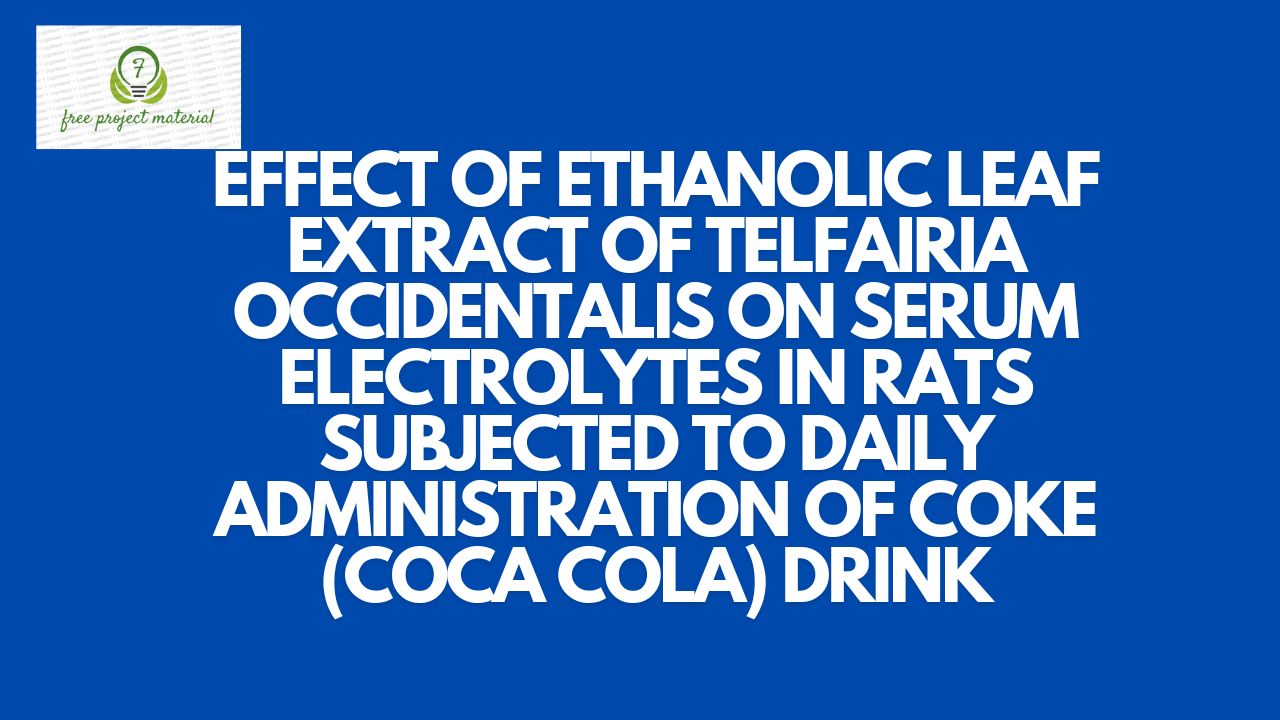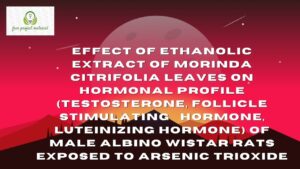ABSTRACT
The effect of ethanol leaf extract of Telfairia occidentalis was investigated on the serum electrolyte in albino wistar rats subjected to daily administration of coke drink. In this study 25 rats were randomly divided into five groups with each group comprising of five animals. Group 1 served as the normal which was given only feed and distilled water . Group II served as the negative control which was given coke, group III was administered with 250mg/kg of the leaf extract and coke, Group IV was given 350mg/kg of the leaf extract and coke, group V was administered with 450mg/kg of the extract and coke. The result of the analysis shows that there was no significant change in sodium (Na+), potassium (K+), chloride (Cl–) and bicarbonate (HCO3–) between the normal group, negative control and the treated groups (p<0.05). A significant increase was observed in calcium in group II (negative control) compared to the group I (normal) but there was no significant change between the negative control group and other treated groups (i.e. group 3, 4 and 5) (p<0.05) these results indicate that coke has the capacity to alter the mean Ca2+ level but there was no significant change on the serum electrolytes in the group treated with the leaf extract compared to the normal and the control, suggesting that Telfairia occidentalis has the capacity to modulate serum electrolyte balance.
TABLE OF CONTENTS
TITLE PAGE – – – – – – – – – i
CERTIFICATION – – – – – – – – ii
DEDICATION – – – – – – – – iii
ACKNOWLEDGEMENTS – – – – – – – iv
ABSTRACT – – – – – – – – – v
TABLE OF CONTENTS – – – – – – – vi-ix
CHAPTER ONE
INTRODUCTION
1.1 Background of the Study – – – – – – 1-4
1.2 Aim and Objectives of the Study- – – – – 4
1.2.1 Aim of the Study – – – – – – – 4
1.2.2 Objectives of the Study – – – – – – 4-5
1.3 Scope and Limitation – – – – – – 5
CHAPTER TWO
LITERATURE REVIEW
2.1 Taxonomy of Telfaiaria occentalis – – – – 6-7
2.2 Phytochemical Constituents Of The Root, Stem and
Leaves of Telfairia occidentalis – – – – 7-9
2.3 Nutritional and Antinutritional Constituents
of Telfairia occidentalis – – – – – – 9-10
2.4 Medicinal Benefits of Telfairia occidentalis – – – 10-12
2.5 Toxicity of Telfairia occidentalis – – – – – 12-14
2.6 Important Electrolytes in the Body – – – – 14-15
2.6.1 Sodium – – – – – – – – 15-16
2.6.2 Calcium – – – – – – – – 16
2.6.3 Chloride – – – – – – – – 16
2.6.4 Bicarbonate – – – – – – – – 17
2.6.5 Potassium – – – – – – – – 18
2.7 Physiological Importance – – – – – 18-19
2.8 Electrolytes Imbalance and Symptoms of
Electrolytes Imbalance – – – – – – 20-21
2.9 Symptoms of Electrolytes Imbalance – – – – 21-22
CHAPTER THREE
MATERIALS AND METHODS
3.1 Chemicals and Reagents – – – – – – 23
3.2 Methods – – – – – – – – 24
3.2.1 Collection Of Plant Materials And Aqueous Extraction – 24
3.2.2 Preparation of Leaf Extract – – – – – 24-25
3.3 Experimental Animals – – – – – – 25
3.4 Experimental Design – – – – – – 26-27
3.5 Collection of Blood Sample – – – – – 27
3.6 Determination of Electrolytes Concentration in Serum – 28
3.6.1 Determination of Sodium (Na+) Level – – – – 28
3.6.2 Determination of Calcium (Ca2+) Level – – – – 28-29
3.6.3 Determination of Chloride (Cl–) Level – – – – 29
3.6.4 Determination of Bicarbonate (HCO3–) – – – – 29
3.6.5 Determination Potassium (K+) Level – – – – 29-30
3.7 Statistical analysis – – – – – – – 30
CHAPTER FOUR
RESULT AND DISCUSSION
4.1 Result – – – – – – – – – 31-33
4.2 Discussion – – – – – – – – 33-36
CHAPTER FIVE
CONCLUSION AND RECOMMENDATION
5.1 Conclusion – – – – – – – – 37
5.2 Recommendation – – – – – – – 37-38
References
CHAPTER ONE
INTRODUCTION
1.1 Background Of The Study
Telfairia occidentalis (fluted pumpkin- common name) Ugu (Igbo language, Ikong ubong (Efik and Ibibio language) is a tropical vine grown in west and central Africa as leaf vegetable and for its edible seeds.
The leaf is used locally as a blood booster due to the abundance of blood enriching minerals such as iron, potassium, sodium, phosphorus, vitamins (thiamin, riboflavin, nicotinamide, ascorbic acid) and phytochemicals in the plant (Koyode and Kayode, 2011). Telfairia occidentalis leaf is also used in the treatment of infertility (Nwangwa et al., 2007) liver problem and diabetes.
Vegetables and fruits include a diverse group of plant foods that vary greatly in content of energy and nutrients, and are universally promoted as healthy (Slavin and Lyoyd, 2012). Vegetables supply dietary fibre which has been linked to lower incidence of cardiovascular disease and obesity (10m, “Institute of medicine”, 2002). T. occidentalis plants is grown in the rain forest zone of many nations of West Africa but occurs mostly in its cultivated form in various parts of Southern Nigeria (Basu et al., 2010). It is a darkish green leafy medicine for the management of many diseased in Nigeria (Saau et al., 2010). T. occidentalis which belongs to the family of cucurbitaceae is a diocious, perennial vine shrub and partially drought – tolerant. The plant consist of a root, stem, leaves (Horsfall and Spiff, 2005). Phytochemical evaluation of the vegetable reveals that it contains oxalates, saponins, glycosides, flavonoids and resins (Tindall, 1999). The toxicity of Telfairia occidentalis has been attributed to the alkaloids and saponins present in the roots and leaves, while the free radical scavenging activity, chemopreventive and protective effects of the plant have been reported to be due to the presence of high amount of flavonoids and phenolic compounds (Nwanna and Oboh, 2007). A similar trend is observed in the metropolitan areas of the developed countries where the use of plants and plants products have increased tremendously with about 33% of population using alternative medicine yearly. A part from the medicinal values, plants provide foods, shelter and clothing for human beings and domestic animals ever since the advent of civilization (Afang et al., 2011). According to World Health Organization, about 80% of people (mainly in the developing countries) rely on or choose to use medicinal plants to cover all or parts of their health care needs (WHO, 2002). Such upsurge in affinity for herbal remedy is probably due to a number of factors ranging from easy accessibility, non- involvement of experts consultation, safety of use and inadequacy of primary health care services.
Soft drinks consumption (SDC) had increased worldwide in the past two-three decades (Nielsen and popkin, 2004). Their effects on health are unclear, although epidemiological studies pointed toward its association with obesity, kidney, liver diseases and osteoporosis. Soft drinks contain predominantly water, phosphoric acid, caffeine, sugar in the form of sucrose and other chemicals in the form of preservatives, colorings and flavours (Adjene et al., 2010). Contents of soft drinks (Coca-cola) coke have a bad effect on human health caffeine in carbonated beverages is deliberately added to make individuals addicted, and is readily absorbed compared with any other drink (Rapiri et al., 2001).
1.2 Aim And Objectives Of The Study
1.2.1 Aim of the Study
The aim of the study was to evaluate the effect of ethanol leaf extract of Telfairia occidentalis on some serum electrolytes in normal albino wister rats, subjected to daily administration of coke (Coca-cola) drink.
1.2.2 Objectives Of The Study
To determine the effect of ethanol leaf extract of Telfairia occidentalis extract on the
(I) Serum calcium (Ca2+) concentration
(ii) Serum chloride (Cl–) concentration
(iii) Serum sodium (Na+) concentration
(iv) serum bicarbonate (HCO3–) Concentration
(v) Serum potassium (K+) concentration in rats subjected to daily administration of Coca-cola (coke) drink.
b(i) To make recommendations based on the result on the effects of the ethanol extract of Telfairia occidentalis on the rats thus treated.
(ii) To make recommendations on the health effect of drinking coke on a daily basis.
1.3 Scope and Limitations
The design of this research work was to investigate and assess the effects of ethanolic leaf extracts on Telfairia occidentalis in normal Albino wistar rats. Due to time, lack of facilities and financial constraint this research work was limited to the evaluation of the major electrolytes in the animals.


